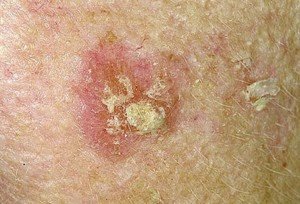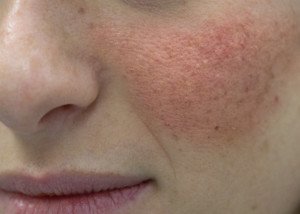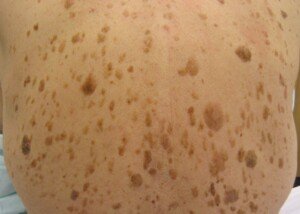
That patch of yellowish overgrowth of skin that you think has been seborrheic dermatitis all this time may actually be actinic keratosis, a precancerous lesion.
Classically, actinic keratosis (aka solar damage) presents as a range of pink colors, coming up in patches or splotches that can be felt by one’s fingertips as having a rough or sandpaper-like texture. The face, plus in bald men the scalp, are common areas for these atypical cells.
But can an actinic keratosis ever be yellow?
“Yes — actinic keratoses can range from yellow and white slightly scaly patches to hyperkeratotic [thick] papules on the face and body,” says Nita Patel, MD, Medical Director of Advance Dermatology and Laser Medical Center in Marina Del Rey, CA.
The image at the top is an actinic keratosis. Note the color combination resemblance to seborrheic dermatitis, a benign condition that, like AK, is very common.
“Yellow scaly patches can resemble seborrheic dermatitis when they are in the typical distribution seen in this medical condition.
“Yellow scaly patches between the eyebrows and near the nasolabial folds [smile lines] are typically seen in seborrheic dermatitis.
“If these patches do not respond to standard treatment, such as ketoconazole 2% cream, they could be actinic keratoses.”
Another tipoff that the lesion is actually an actinic keratosis is that it does not easily flake or madly itch.
“Typically a small number of actinic keratoses would be treated with cryotherapy with liquid nitrogen,” says Dr. Patel.
In this case, a dermatologist simply sprays, from a canister, the icy-feeling liquid onto the affected skin. It stings but is tolerable.
The lesions may take up to four weeks to completely fall off.
“If a larger area is involved then immunomodulators such as imiquimod or other topical options such as 5-fluorouracil cream [Efudex] would be considered.”










































